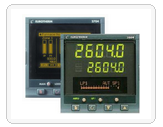
|
2604/2704 碳势控制表功能说明
Carburising When Mild steels or certain low carbon steels are heated at temperatures above 900oC in a carbon rich atmosphere, the surface of the steel absorbs carbon by diffusion. The depth of carbon enrichment depends on the time and temperature of the treatment known as carburising. The presence of carbon in the steel causes a change in its physical properties. Accurate control of both temperature and carbon potential are needed to achieve the required profile of carbon enrichment. Zirconia Sensor Theory The Zirconia probe generates a millivolt signal based on the ratio of oxygen concentration between the reference airside of the probe (outside the furnace) and the amount of oxygen actually inside the furnace. Temperature is measured using a built in thermocouple at the tip of the probe. Together, these signals are used by the 2604 zirconia function block to calculate the actual percentage of carbon in the furnace atmosphere. The 2604 oxygen probe interface is compatible with most commonly used zirconia probes.
2604 Integrated Furnace Controller Synchronised temperature/carbon profiles Automatic probe cleaning Furnace sooting alarm Probe deterioration alarm Temperature control of quench
A 2604 three loop controller is used to control both furnace temperature, carbon potential and quench. In many batch furnace applications a setpoint programmer is used to generate temperature and carbon profiles which are synchronised to a common time base. Furnace Temperature Control Although the sensor input of the temperature loop can come from the zirconia probe, it is more common for a separate thermocouple to be used. The heat control output can either be connected to gas burners or thyristors. In some applications a cooling output may also be connected to a circulation fan or an exhaust damper. Furnace Atmosphere control In atmosphere loops the controller increases the carbon potential by opening a solenoid valve which allows a carburising gas (ie propane) to enter the furnace. Conversely, to decrease the carbon potential, air or nitrogen is introduced into the furnace. Automatic probe cleaning functions ensure that the reading is accurate, whilst probe health and sooting alarms warn of a deterioration in the probes performance. Quench Temperature Control Steel parts are rapidly cooled (Quenched) from around 850oC to obtain the desired hardness, strength or toughness. Depending on the material being treated, the quench medium is usually oil or water. The quench control loop maintains the quench bath at the desired temperature and provides a quench timer facility. Sooting Alarm As well as alarms on the temperature and carbon potential in the furnace the 2604 can trigger an alarm, when the atmospheric conditions are such that carbon will be deposited as soot on all surfaces inside the furnace, including the workpiece. Avoiding sooting protects the furnace lining, maintains the accuracy of the zirconia probe and stops formation of a soot barrier on the workpiece which can prevent carbon diffusion. Automatic Probe Cleaning The 2604 has a probe clean and recovery strategy that can be programmed to occur between batches or manually requested by an operator. A short blast of compressed air is used to remove any soot and other particles that may have accumulated on the probe. Once the cleaning has been completed the time taken for the probe to recover is measured. If the recovery time is too long this indicates that the probe is ageing and replacement or refurbishment is due. During the cleaning and recovery cycle, the %CP reading is frozen thereby ensuring continuous furnace operation. Enriching Gas Correction A gas analyser can be used to determine the CO concentration of the enriching gas. If an analogue output is available from the analyser, it can be fed into the 2604 to automatically adjust the calculated % carbon reading. Alternatively, an operator may enter this value manually. |


